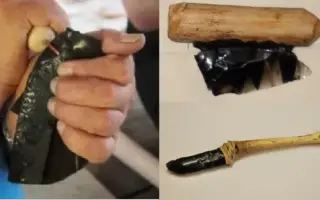Purpose of Baton
Whether faced with an emergency or just on your latest outdoor adventure, expanding knowledge crucial to your survival will never be a waste of effort. Batoning is a great technique to learn for any outdoorsman. Most people make the mistake that they assume they can just “cross that bridge when they get there.”
Yet, it’s also important to know these techniques and really understand how to perform them properly before the situation presents itself. By doing so, you can save time and abundant reserves of energy that you may need to pull from during subsequent tasks.
Trial and error are not always the best format for learning new outdoor skills, especially when yours or someone else’s life really depends on your understanding of it, which certainly applies to batoning.
What is Batoning?
A simple description of batoning is a survival technique in which an individual uses a strong and very sharp knife to split wood using a hard and heavy baton-like object. This is similar to the motion of driving a nail using a hammer.
This is usually done for the purpose of splitting wood to create kindling (material necessary for creating fire), produce boards, or even to separate the dry inner layers of wood that have a wet exterior.
What is the Advantage of Using This Technique?
When faced with the goal of splitting wood, it is an easier and much more practical alternative as compared to chopping.
In addition to these two benefits, batoning usually requires less effort and can accomplish the goal of getting the wood to the right state faster than you would with just using the chopping technique.
It also accomplishes better results, as the wood can be cut proportionally when batoned rather than if it’s chopped.
- People who are not knowledgeable in chopping can still split wood through batoning – chopping requires the person to aim before driving the chopper or the knife into the wood. For a novice outdoorsman, it is a difficult skill to master. It is contrary to batoning. Since most people don’t have the brute strength necessary to split a piece of wood with an everyday carry blade, they can accomplish the same result using a batoning technique.
- In most cases, you won’t find yourself in survival situations with an axe. Understanding how to baton is far more practical as a survival technique. You’re more likely to be found in an emergency situation with your survival or EDC knife on hand.
![How to Baton Wood With a Knife [6 Easy Step] 1 ontario spec plug gen ii sp53 knife](https://knivesngear.com/wp-content/uploads/2022/03/ontario-spec-plug-gen-ii-sp53-knife-1024x451.jpg)
What Are the Disadvantage of This Technique?
This technique also has its weak points, which are the following:
- Batoning wet logs can be more difficult, requiring more energy as compared to chopping.
- The smaller the blade, the more challenging it can be to split larger pieces of wood.
- You risk breaking or damaging the knife if done improperly.
Don’t Risk Breaking Your Knife While Batoning.
The last thing you’ll want to do in an emergency situation is damaging your most important survival tool. Breaking or damaging the blade is most likely caused by striking the knife at an angle instead of driving it straight down. It can also be due to using the wrong type of object as a baton to perform the technique.
You should always try to use another piece of wood to strike the knife, as using a rock or other object can chip away or crack the blade. Using anything stronger than the blade can result in permanent damage such. Batoning with wood along with making contact in a straight down motion will keep your knife intact.
Full tang or through-tang knives are obviously the best choices because of their durability. You won’t always have the option of choosing the type of blade to use, but if the opportunity presents itself, avoid choosing something with a partial tang embedded in plastic. You’ll truly be putting the manufacturing to the test.
10 Best Batoning Knife – Our  Recommendations:
Recommendations:
![How to Baton Wood With a Knife [6 Easy Step] 2 Broken Partial Tang Knife](https://knivesngear.com/wp-content/uploads/2022/01/broken-partial-tang-knife.jpg)
So How Do You Baton Wood?
Here are a few short steps to start you on your path to adding this essential technique to your arsenal of survival skills. Remember to step out and practice this technique in a controlled environment before taking it on your next trip. You’ll also want to use one of your less expensive or older knives when practicing, so you don’t damage a more expensive blade.
- Start by placing the wood you’re going to be batoning into a groove on a solid patch of dirt or on an object that can take the force you’re going to be placing on the wood.
- Place the knife in the middle of the wood that will be split with the sharp edge facing down. If you want to make the process much easier, find a split or crack in the wood and start there with your knife. Ensure that the knife’s spine is straight up to avoid hitting it at an angle and risking the integrity of the blade.
- Take the second piece of wood you’ll use as your baton to strike the center of your knife until it penetrates the wood.
- Baton directly onto the blade spine. Always be sure to avoid batoning near the tip of the knife. Strike the part of the blade that is near the center and is less susceptible to breaking.
- Adjust the knife every now and then to ensure that you are striking the stronger part of the blade and that the split is proportional.
- As much as possible, avoid hitting the handle of the knife. Similar to the tip, it is weaker than the center of the knife blade. However, you can strike it lightly if you feel that it is going away from the intended alignment.
Batoning is only one technique that can be used to create shelter, build a fire, or just split some wood. Practice and perfect this technique so that one day it can not only save your life, it can also save your knife from sustaining permanent damage.
![How to Baton Wood With a Knife [6 Easy Step] 3 Taras Kulakov](https://knivesngear.com/wp-content/uploads/2021/06/Taras-Kulakov.jpg)
Hi, my name is Taras Kulakov and I’m a knife enthusiast. I have been collecting knives for over 30 years and I’ve owned literally thousands of different models over that time. My goal with this site is to share some of what I’ve learned about knives. You can find more info about Taras Kulakov here.
Last update on 2023-03-13 / Affiliate links / Images from Amazon Product Advertising API

 Recommendations:
Recommendations:


